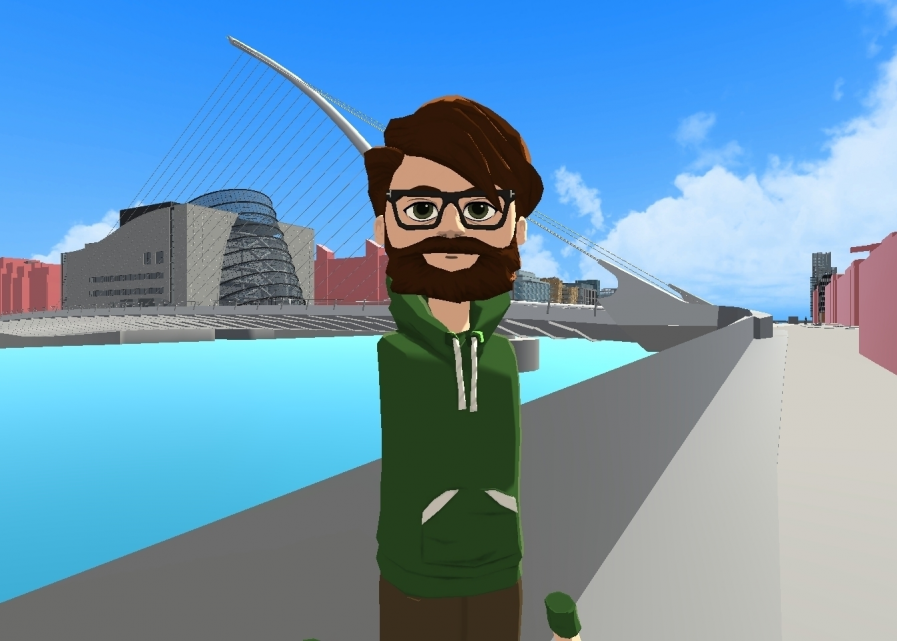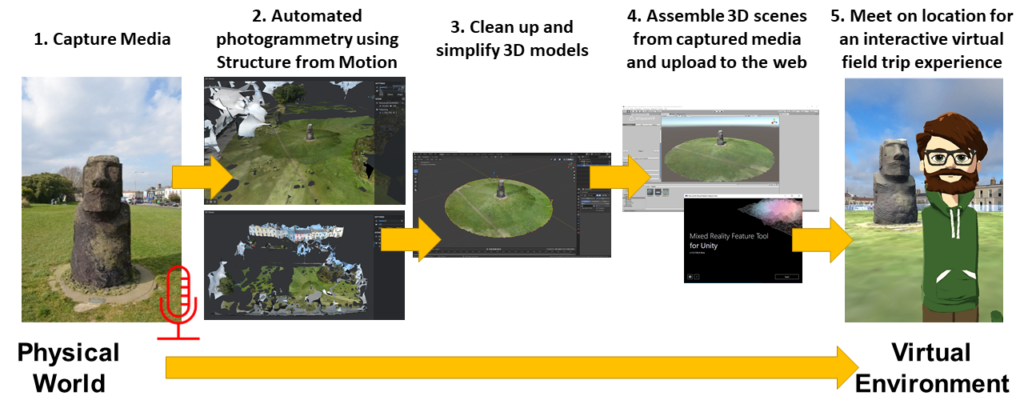The Virtual Field Trip: Sharing experiences of COVID-19 through online 3D digital content.
2nd October 2020
The Impact of Covid-19: Telling your story
The coronavirus disease 2019 (COVID-19) was first identified in December 2019, resulting in a sustained global pandemic. On the 29th of February 2020, the Republic of Ireland confirmed its first case, and in the following weeks, multiple instances were reported causing the government to issue strict guidelines to delay the spread of the virus. Since then, the pandemic and the subsequent lockdown have drastically disrupted society. As vaccines are rolled out, and employment sectors begin to formulate and execute plans to return to work, the following project sought to capture personal accounts of lockdown via the integration of place-based photogrammetric 3D media and social virtual reality (VR) technology. Through the combined use of open-source tools, multimodal site-specific 3D data, and a free-to-use social VR platform, it was possible to engage in community participation as artistic co-creative practice and undergo a uniquely creative form of storytelling and content creation. Our participant reports provide data relating to personal experiences of the global pandemic phenomenon, using a global platform for online communities to share their intangible experiences and community support via virtual field trips worldwide. We also anticipate our research as a starting point for future technology-mediated co-creative arts practice using social VR.

The Virtual Field Trip
The processes outlined below were explored to create 3D environments for digital storytelling and achieve our collective virtual field trip goals. This process involved five unique steps [35]; see Figure 2. These steps were designed to utilize open-source and free-to-use software to minimize cost and maximize accessibility. No coding abilities were required to follow this process, but basic digital skills were necessary. Visual PDF guides with accompanying video tutorials were provided to assist our community of storytellers, from: https://virtualarchitectures.github.io/ground_truthing_and_virtual_field_trips/
The process we outline has five stages:
- Ground Truthing: visit a specific place that represented the impact of and personal response to COVID-19 lockdown on an individual basis, explore this place first-hand, and capture it by taking images and recording ambient sound.
- Photogrammetry: use free and open-source software to analyze the digital images automatically and reconstruct a spatially accurate and textured 3D model.
- Model Cleaning and Preparation: use 3D editing software to reduce unnecessary detail and complexity in the model.
- Assembling the Virtual Environment: build the 3D scene, arrange the 3D model(s), and add 3D spatial sound in a game engine.
- The Virtual Field Trip: upload the scene to AltspaceVR, invite other community members to join in on a virtual field trip, share personal experiences of lockdown, and remodify the environment accordingly.

Following the 3D reconstruction process, participants are then encouraged to discuss their experiences of COVID-19 and respond to questions concerning their chosen locations. The resultant community arts content can be visited in real-time as a virtual field trip in AltspaceVR.
- The River Liffey Bench – World Code: HUP670
- Temple Bar – World Code: GGI510
- The Hungry Tree – World Code: RKL584
- Clontarf Promenade – World Code: ZPS227
- The Fairy Garden – World Code: WGL323
- Wish I was Here – World Code: TSD404
- James Joyce Tower – World Code: YBM425
- DCU Main Entrance – World Code: QRZ093
- Matthew Kane’s Grave – World Code: GKX272
- Bath Time! – World Code: FBN377
- How Soon is Now – World Code: GKX272
“I guess the most adverse effect it had on my life was the limitations imposed due to the lockdown, and that kind of diminished our social life so that I did not leave the house.”
“I think the biggest change is obviously not going out or anywhere and then consequently not meeting people. It was a very socially isolated time, and yeah, I think that’s the biggest challenge.”
“I’m quite happy with entertaining myself, so staying at home and reading or watching stuff or playing video games is ok with me. I don’t need to go out every day or even every week.“
“I count myself fairly lucky because I have had access to open spaces like the promenade, and the beach isn’t too far. I like working from home. I don’t miss the commute, so I feel like I’ve been luckier than many people.”
“I find nature to be quite calming and quite good in terms of mental health, and now obviously, because of my whole experience with the tree blooming when my daughter came home, I find that I’m happy when the tree blooms.”
“I kind of feel like during this past year, we’ve been in a liminal space. For most people, it’s all kind of just waiting. And now we’re coming out.“
“…one of the ways my experience of lockdown has changed me is by changing my attitude towards the potential of using other media as a way of representing that reality in which I put so much importance on location [by showing] that there are other ways of representing it through alternative virtual realities.“
“Everybody is very isolated and restricted in the tens of square meters of their house, the square meters of their bedrooms, and every time you imagine you are staying in the same place, working where you sleep and study. That obviously makes people feel unhappy or even depressed.“
“I guess this place is probably somehow linked with me, kind of being partially orphaned, so that’s significant in anybody’s life.“
“I think in the beginning, I could have three, four, maybe even five baths a week because everything was just so calm, even though the world was going crazy, it was so peaceful.“





